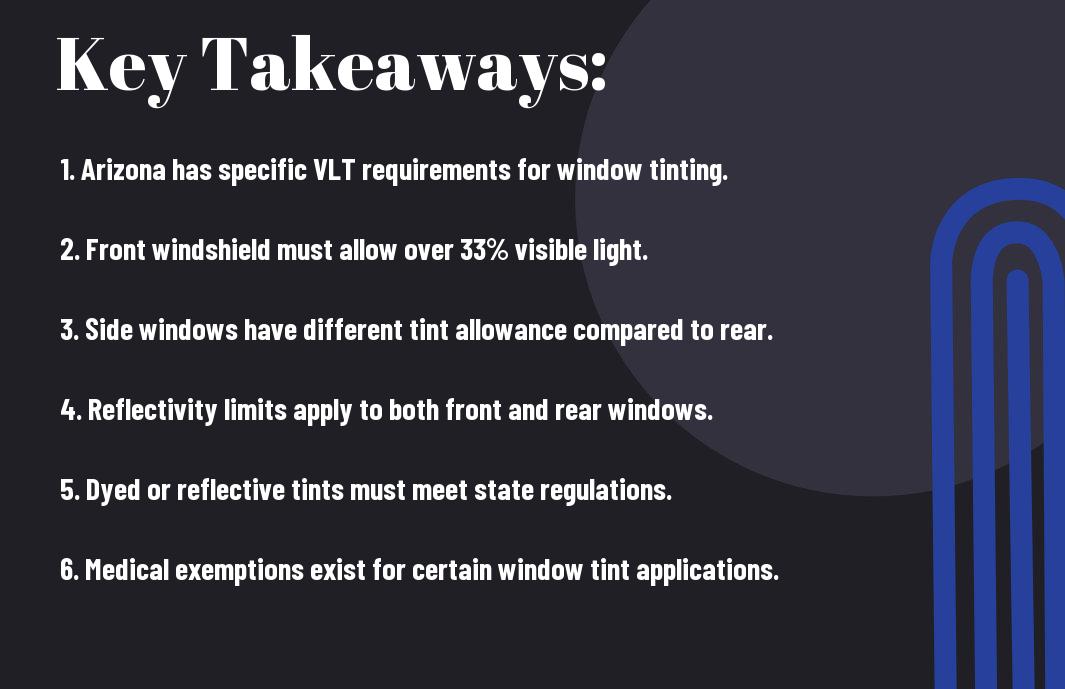Window tinting can significantly enhance the comfort and aesthetic of your commercial property in Arizona, but it’s vital to understand the specific regulations that govern it. You may not be aware of the various limits on the types of films you can use, their darkness, and the areas where tinting is permissible. In this blog post, you’ll gain insight into the often-overlooked aspects of window tinting regulations to ensure your business remains compliant while benefiting from the advantages of tinted windows.
Overview of Window Tinting Regulations
The window tinting industry is governed by specific regulations aimed at ensuring public safety, aesthetic harmony, and vehicle functionality. These laws vary from state to state, and it is important for you to understand the rules in Arizona to avoid potential fines or legal issues. In this climate, when the sun can be particularly harsh, proper window tinting not only enhances privacy but also improves comfort for both drivers and passengers. In this chapter, we will explore into the little-known regulations surrounding commercial window tinting in Arizona, outlining their significance and impact.
Importance of Window Tinting Laws
Along with enhancing the aesthetics of your vehicle or commercial property, window tinting laws play a vital role in ensuring that your windows remain functional and safe. These regulations are designed to protect both the driver and other road users by maintaining visibility and preventing distractions. By adhering to these tinting laws, you also contribute to the overall safety and well-being of your community.
Moreover, window tinting laws can vary significantly across different jurisdictions. It’s important for you to familiarize yourself with the specific rules in Arizona to ensure compliance. Understanding these regulations not only helps you avoid potential penalties but also ensures that your window tinting enhances your overall experience rather than hinder it.
General Purpose of Window Tinting
At the core, the general purpose of window tinting is to provide a range of benefits that improve the comfort and functionality of your vehicle or commercial space. Window tinting can reduce glare from the sun, keeping you and your passengers comfortable during long drives or working hours. Moreover, tinted windows can also help in regulating the interior temperature, consequently reducing the strain on your air conditioning system and leading to better energy efficiency.
Also, window tinting serves as a protective barrier against harmful UV rays, which can adversely affect both your skin and the interior of your vehicle. This added layer of protection can help in preserving your upholstery and other surfaces from fading, extending the life of your vehicle or building. Ultimately, understanding the purpose of window tinting alongside the regulations governing it can help you make informed decisions that enhance both your comfort and your investment.

Arizona Window Tinting Regulations
One of the most important aspects of ensuring your vehicle complies with local laws is understanding the state regulations regarding window tinting. Each state has its own set of guidelines, and Arizona is no different. In this chapter, you will find an overview of the specific laws that regulate window tinting in Arizona and how they apply to you as a vehicle owner.
Overview of Arizona State Laws
State laws in Arizona dictate the permissible levels of window tinting on various vehicle windows. For instance, the front windshield is required to allow more than 33% of light in, while the front side windows must allow at least 33% of light as well. The back side windows and the rear window can be tinted to any darkness level, granting you the flexibility to choose a tint that aligns with your preferences while remaining compliant with the law.
You should also be aware that particular types of tints, such as reflective materials, are subject to restrictions. Arizona law limits the reflective tint on front windows to 35%, meaning it’s necessary to select window films that do not exceed this specification. Keeping your window tint within state regulations ensures you avoid potential fines and makes your driving experience safer.
Department of Transportation Guidelines
Above and beyond state laws, the Arizona Department of Transportation (ADOT) has established specific guidelines that outline the standards for window tinting. ADOT provides detailed information on the types of materials that can be used for tinting, offering recommendations to avoid materials that could impair visibility or cause safety concerns.
Laws specified by the ADOT emphasize the importance of clear visibility for both drivers and pedestrians. If you choose to install window tint on your vehicle, ensure that the installation adheres to the quality and material standards set forth by ADOT. Noncompliance could not only result in penalties but also impact your safety on the road. Always verify that the installation meets these guidelines to enjoy the benefits of window tint without the accompanying legal headaches.

Legal Limitations on Tint Darkness
For those considering commercial window tinting in Arizona, understanding the legal limitations on tint darkness is necessary. State regulations dictate specific standards for various windows in your vehicle, ensuring safety for both drivers and pedestrians. It’s important to comply with these guidelines to avoid penalties and to ensure maximum visibility while driving. Failure to adhere to these regulations can lead to fines and the potential need to remove or replace your tinting.
Front Windshield Restrictions
One of the primary considerations is the front windshield. Arizona law requires that the front windshield must allow more than 33% of visible light to pass through. This means that any tint applied cannot be darker than a shade that permits this level of light transmission. Additionally, any tint applied to the front windshield must not extend below the AS-1 line, as marked on the windshield, or be more than four inches from the top. Adhering to these stipulations is vital to ensure you remain within the legal limits.
Front Side Windows Requirements
Between the front windshield and your vehicle’s side windows, there are specific requirements you need to follow. Your front side windows must allow more than 33% of visible light to pass through, similar to the front windshield regulations. This is designed to ensure that you and your passengers are adequately visible to law enforcement. Furthermore, darker tints are allowed on back side windows and rear windshields, offering you more flexibility in terms of privacy and heat reduction.
Front side windows are a significant focus of Arizona’s tint laws, as they are instrumental in maintaining the safety and visibility required on the roads. By adhering to the regulations regarding tint darkness, you can ensure that your vehicle remains compliant while still offering a touch of style and functionality.
Back Side Windows and Rear Windshield
Across the back side windows and rear windshield, Arizona offers more leniencies in tint darkness compared to the front windows. The law permits nearly any level of tint on these areas, allowing you to enhance your vehicle’s privacy and aesthetics without as many restrictions. While these windows can be tinted darker, it’s still necessary to keep in mind that the tint must not obscure visibility to an unsafe degree, especially for the rear view.
Consequently, while you can enjoy greater freedom with your back side windows and rear windshield tinting, ensuring that you maintain adequate visibility is necessary for your safety and compliance with the law. This allows for a balance between achieving the desired aesthetic and following local regulations. Always consult with a professional to determine the best options for your vehicle that adhere to Arizona’s tinting laws.
Checking for UV Protection
Keep in mind that UV protection is one of the most significant benefits of window tinting. Not only does it enhance the aesthetic appeal of your commercial property, but it also provides important protection against harmful ultraviolet rays. Exposure to UV rays can lead to a variety of health issues, including skin damage and an increased risk of skin cancer. By selecting window films that offer UV protection, you can create a safer environment for both employees and customers, while also preserving the integrity of your furnishings and equipment that may otherwise fade or deteriorate under prolonged sunlight exposure.
Significance of UV Protection
On top of safeguarding health and property, effective window tinting with UV protective features also contributes to energy efficiency. By reducing the amount of heat that enters your space, tinted windows can lessen the workload on your air conditioning systems. This not only saves you money on energy bills but also contributes to a more comfortable atmosphere within your commercial property. As a business owner, understanding the benefits of UV protection helps you make informed decisions about your window tinting options.
Arizona’s Specific UV Protection Guidelines
The regulations in Arizona emphasize the importance of reducing UV exposure through appropriate window film usage. Particularly for businesses that experience extensive sunlight throughout the year, it is important to understand the local laws that govern how much UV light can enter your premises. Arizona law specifies that window tints must not exceed certain levels of light reflectance and transmission to ensure that you still have adequate visibility, while also maintaining a protective barrier against harmful rays.
Significance of these guidelines extends beyond mere compliance. They are in place to help you protect the health and comfort of everyone in your building while permitting sufficient natural light. When opting for window tinting solutions, you should look for films that comply with Arizona’s standards but still provide maximum UV protection. This ensures that you are not only following the law but also taking proactive steps to create a safe and efficient environment that benefits your business in more ways than one.

Permit and Certification Requirements
Despite the common belief that installing window tint is a straightforward task, in Arizona, you must adhere to specific regulations that govern permits and certifications for commercial window tinting. These regulations are designed to ensure that the tinting applied is compliant with local laws, guaranteeing safety and functionality while protecting the aesthetic appeal of commercial buildings. Understanding these requirements can help you avoid penalties and ensure your property remains in line with state standards.
Installation Permit Necessities
The installation of window tint for commercial properties in Arizona may require you to obtain a permit before proceeding with the work. Typically, this entails submitting an application to your local building department, which outlines the specifics of your project, including the type of tint being used, the areas affected, and any other relevant details. It’s imperative to check with your municipality to understand the precise requirements, as they can vary significantly from one area to another.
In some cases, you may be required to provide documentation proving that the tint adheres to state regulations on reflectivity and color. Failure to secure the necessary permitting can lead to delays in your project and potential fines, so ensure that you guide yourself through this process carefully before commencing any work.
Certified Window Tinting Professionals
After securing the required permits, you must also consider hiring certified professionals for the installation of your window tint. In Arizona, these individuals are trained to follow both the legal guidelines and best practices for applying window films. Their expertise ensures that the installation not only meets aesthetic requirements but also complies with state codes addressing factors like heat rejection and glare reduction.
Due to the technical nature of window tint application, certified professionals possess the skills necessary to avoid issues such as bubbling, peeling, and improper application, all of which can lead to costly rework. By choosing a certified installer, you can have peace of mind that your commercial property will meet all regulatory requirements while providing the benefits of enhanced privacy, energy efficiency, and UV protection.
Consequences of Non-Compliance
Unlike many other regulatory matters, the rules governing commercial window tinting in Arizona are strictly enforced. Failing to adhere to these regulations can lead to significant repercussions that you should not overlook. The state’s laws dictate specific standards for window tinting, and non-compliance can result in complications that affect both your business operations and finances.
Fines and Penalties
After receiving a citation for non-compliance with Arizona’s window tinting laws, you may face fines that vary in scale depending on the severity of the violation. These monetary penalties can accumulate quickly, and repeated offenses may lead to increased fines, thereby stressing your budget and potentially affecting your bottom line. In some cases, your business could also face additional penalties, including a halt on your commercial activities until the issue is resolved.
Additionally, fines may not be your only concern. Regulatory agencies may also enforce other consequences, such as the requirement for a mandatory inspection of your premises, which can further disrupt your daily operations. Therefore, staying informed about and compliant with local regulations can save you from significant financial setbacks and operational challenges.
Restoration of Legal Tint Levels
One of the immediate actions you will need to take if you are found in violation of tinting regulations is restoring your window tint to legal levels. This process involves removing the illegal tint and replacing it with an approved option that meets state standards. This restoration can be both time-consuming and costly, which can upset your business operations temporarily.
Fines aside, the process of restoration often requires hiring professionals experienced in window tint removal and installation, which can lead to further expenses. Additionally, you may have to schedule inspections to prove compliance after the restoration is completed, adding more time and likely more costs to your retreat back toward conformity. It’s in your best interest to familiarize yourself with the regulations beforehand to avoid these headaches altogether.
To Wrap Up
Conclusively, understanding the little-known regulations for commercial window tinting in Arizona is important for ensuring compliance and enhancing the aesthetic appeal of your property. You must familiarize yourself with factors like VLT percentages, reflective limits, and specific requirements for different types of buildings. By adhering to these regulations, you can avoid potential fines and complications while enjoying the numerous benefits window tinting offers, such as UV protection and heat reduction.
Additionally, staying informed about any changes in legislation will help you maintain your property’s value and keep it looking its best. You should also consider consulting with a professional window tinting service that is well-versed in local laws to ensure your installation meets all requirements. This proactive approach not only protects your investment but also contributes to a more comfortable and efficient environment for your business.






Aw, this was a really nice post. In idea I wish to put in writing like this moreover – taking time and actual effort to make a very good article… however what can I say… I procrastinate alot and by no means seem to get one thing done.
Howdy! Someone in my Myspace group shared this site with us so I came to take a look. I’m definitely enjoying the information. I’m bookmarking and will be tweeting this to my followers! Exceptional blog and amazing design and style.
With havin so much content and articles do you ever run into any problems of plagorism or copyright infringement? My blog has a lot of unique content I’ve either created myself or outsourced but it looks like a lot of it is popping it up all over the web without my permission. Do you know any ways to help prevent content from being ripped off? I’d truly appreciate it.
Can you be more specific about the content of your article? After reading it, I still have some doubts. Hope you can help me. https://accounts.binance.com/it/register-person?ref=P9L9FQKY